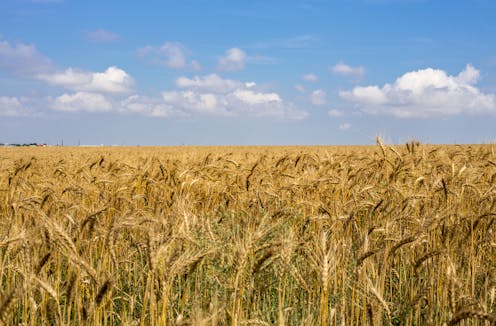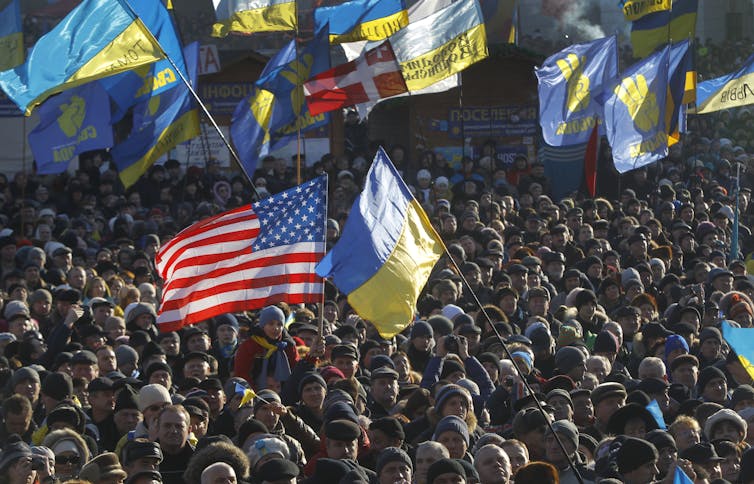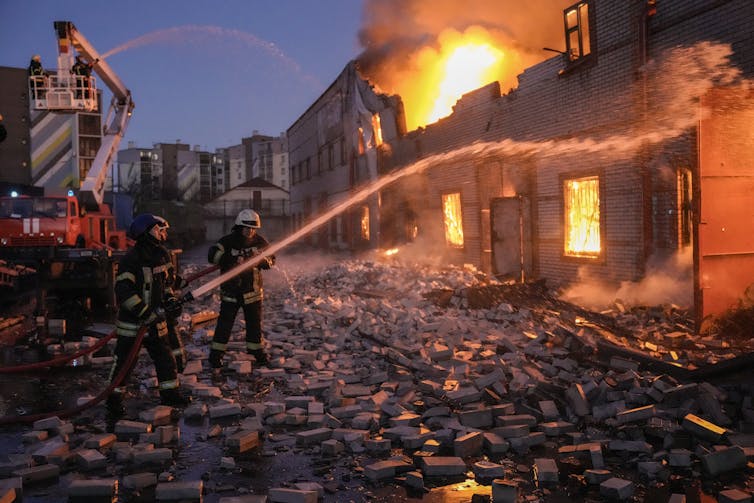Ukraine's economy went from Soviet chaos to oligarch domination to vital global trader of wheat and
Ukraine was becoming increasingly linked with the global economy. Russia’s invasion puts its progress at risk.

Many factories and businesses still function. Other industries like those in information technology have barely missed a beat, with workers continuing to work from areas out of the direct line of fire.
But Ukraine has been largely transformed into a war economy. For example, a women’s shoe maker is using Italian leather to craft military boots, a construction company’s dump trucks were converted into antiaircraft launchers, and a steel and mining group has been making anti-tank weapons and concrete shelters. And many IT workers have joined Ukraine’s hacker army aimed at defending infrastructure from cyberattacks or going on the offensive against Russia.
Yet the economic damage is dire. In the early days of the war, Ukraine’s central bank estimated total output dropped by half. The government estimates Russia has already destroyed well over US$500 billion in economic assets. Substantial damage to airports, seaports and bridges has crippled the country’s infrastructure and ability to trade with other countries.
Beyond its importance to feeding, fueling and supporting its own citizens, Ukraine is also a vital part of the global economy with its exports of wheat, corn and neon. As a native of Ukraine and economics professor, I’d like to provide a primer on the Ukrainian economy, how much it has changed since it was a Soviet republic and the consequences of Russia’s war.
Ukraine’s command economy collapses
Ukraine inherited a “command economy” when it became an independent state after the dissolution of the Soviet Union in 1991. In a command economy, all decisions involving production, investment, prices and incomes are determined centrally by a government.
Moreover, much of it was tied to a Soviet obsession with heavy industry and a massive military industrial complex. In other words, Ukraine’s economy was great at mining ore and building intercontinental ballistic missiles but less so at making the kinds of consumer goods vital for a modern economy.
And so, the economy collapsed soon after independence. Gross domestic product plunged by over 60% in the early 1990s, and inflation skyrocketed to more than 10,000%. For ordinary Ukrainians, this collapse meant massive poverty and hardship: Approximately 50% of households lived on less than $5.50 per day, and life expectancy declined by five years.
This led to the mass privatization of state-owned enterprises as small as a grocery store to as large as giant steel mills – just like in Russia. This also created the class known as the oligarchs, made up of former Communist elites and others with connections in the government who got control over major factories and other key productive assets at little or no cost. Some estimates suggest that over 50% of GDP was controlled by oligarchs.
Although the oligarchs initially helped Ukraine’s biggest businesses restore their productive capacity, jump-starting the economy, they quickly began using their connections to stifle competition. Corruption was endemic and the economy struggled to grow or diversify beyond producing basic commodities and equipment like steel, iron ore and mining equipment. In 2006, for example, base metals made up 43% of exports, followed by mineral products at 10% and chemicals at 8.8%.
And Russia was Ukraine’s top trading partner, buying 56% of all its exports. The U.K. was a very distant second with just 3.4%.
Ukraine’s sources for imports were only a little more diverse. Goods from Russia made up 16% of Ukraine’s imports, second only to America’s 23% share.

Ukraine turns West
Ukraine’s economy began to shift radically around 2014, when Russia annexed Crimea and fomented insurrections in the eastern part of the country.
The events that led to the annexation were largely inspired by a desire on the part of Ukrainians to form closer economic and political ties to Europe and end corruption. An agreement forged in 2013 to more closely integrate Ukraine into the European Union was abruptly dropped a few days before it was to be signed, and the government signaled it planned to align more closely with Russia. Massive street protests ensued, which eventually drove the pro-Moscow president from power in what became known as the Maidan Revolution.
Russia responded by taking Crimea and backing separatists in the Donbas region.
Since then, trade with Russia has plunged as Ukraine strengthened ties with other countries, most notably those in Europe. The government almost immediately resumed negotiations with the EU over the trade agreement and signed it, which lowered or removed tariffs on most goods and resulted in the EU becoming its biggest trading partner.
In addition, the economic crisis brought on by the conflict in the east led the International Monetary Fund to offer a $17.5 billion bailout in exchange for economic reforms that included a crackdown on corruption, an independent central bank and improved democratic processes, many of which Ukraine subsequently implemented.
[Like what you’ve read? Want more? Sign up for The Conversation’s daily newsletter.]
As a result, Ukraine began to send a wider range of goods to the world, especially agricultural products such as wheat and sunflower oil, which was its biggest export ahead of base metals in 2019. Ukraine has some of the most fertile soil in the world.
Another key growth industry in Ukraine has been information technology, which made up 26% of export revenues in 2020. In fact, IT services was its top export to the U.S. in 2021.

Economic gains at risk
Ukraine’s increased integration with the global economy means many of its goods play critical roles in some markets.
Ukraine was expected to make up 12% of global wheat exports in 2022. Egypt, Tunisia and Algeria, for example, depend heavily on Ukraine for their wheat, and there are concerns of famine as a result of Russia’s blockade on ships leaving Ukraine. The picture will only get worse the longer the conflict goes on and if farmers are unable to plant their seeds while war is raging.
Ukraine also plays a critical role in the production of neon, an inert gas that is a key component for lasers used in making chips. Ukraine produces 90% of semiconductor-grade neon used in the U.S.
It’s still unknown how many civilians Russia’s war in Ukraine has killed, and there’s no knowing when the destruction will end. But it’s likely that another victim of the invasion may be Ukraine’s economy and the progress it has made transforming from an unbalanced Soviet economy into a diversified modern one.
Yuriy Gorodnichenko does not work for, consult, own shares in or receive funding from any company or organization that would benefit from this article, and has disclosed no relevant affiliations beyond their academic appointment.
Read These Next
The Bible says little about Jesus’ childhood – but that didn’t stop medieval Christians from enjoyin
Legends about Jesus’ early years that circulated in medieval Europe often drew on apocryphal texts.
Whether Netflix or Paramount buys Warner Bros., entertainment oligopolies are back – bigger and mor
Hollywood has seen this movie before.
Sharks and rays get a major win with new international trade limits for 70+ species
Sharks have had a tough time since the 1970s, when overfishing, habitat loss and a growing trade in…






